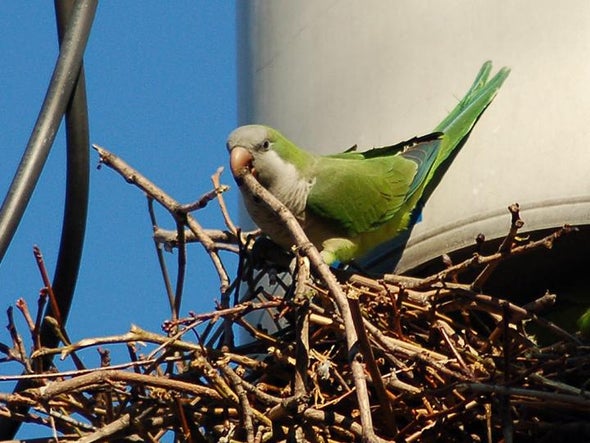(单词翻译:单击)
听力文本
This is Scientific American 60-second Science, I'm Lucy Huang.
You might expect to hear parrots like these in the wild in South America. But these birds are actually nesting in the middle of Chicago. Despite being known as monk parakeets, the green-and-gray squarkers are true parrots. And they've been living in the Windy City since the 1970s. But not just there.
"There are monk parakeets in many, many states. They're breeding in around 21 states."
Jenny Uehling, a Ph.D. student now at Cornell, who was at the University of Chicago when she studied these birds.
"Certain populations will pop up in certain states and then, you know, disappear, but they're by far the most widespread of any of the species."
Uehling wanted to know how many nonnative parrots were living in the U.S. To do this "we used eBird and Christmas Bird Count, or CBC. We use these two databases because they have the largest spatial distribution of data, basically, for the United States."
Uehling and her team looked at data collected from 2002 to 2016 and deduced that there were 56 different species of parrots living free in 43 states. Of these species, 25 of them had become naturalized, that is "able to successfully breed and maintain their own population without the addition of additional individuals from captivity."

Most of these nonnative parrots were either released by owners or escaped from captivity. Some established breeding populations. And some of these new populations are saving entire bird species.
"The red-crowned parrot is declining in its native range, but it's actually increasing in the U.S., and it's becoming pretty common. And so I think that leads to a really interesting question of, you know: Could we possibly use these populations of nonnative parrot species to understand the biology of a species declining in its native range?"
The study is in the Journal of Ornithology.
Florida may have a half-million monk parakeets. And they're even hardy enough to live year-round in Brooklyn and the Bronx, as well as Chicago. And if you've ever heard the racket they make, it's clear that these monks never took a vow of silence.
Thank for listening for Scientific American 60-second Science, I'm Lucy Huang.
参考译文
这里是科学美国人——60秒科学系列,我是露西·黄。
你可能期待在南美野外听到鹦鹉这种叫声。但这些鸟实际上正在芝加哥中部筑巢。尽管被称为和尚鹦鹉,但这些灰绿相间的吵闹家伙是真正的鹦鹉。自上世纪70年代以来,它们一直生活在“风城”芝加哥。但不仅仅在芝加哥。
“很多州都有和尚鹦鹉。它们在大概21个州繁殖。”
珍妮·尤林现在是康奈尔大学的一名博士生,她之前在芝加哥大学学习时研究这些鸟类。
“某些种群会突然出现在某些州之后又消失,但它们是迄今为止分布最广的物种。”
尤林想知道有多少种非本地鹦鹉生活在美国。因此,“我们使用了eBird和圣诞鸟类统计 (简称CBC)。我们使用这两个数据库是因为它们基本上是美国最大的空间分布数据库。”
尤林和团队研究了2002年至2016年间收集的数据,推断出有56个不同种类的鹦鹉生活在美国43个州。在这些物种中,有25种已经归化,也就是说“无需附加额外的圈养个体,就能成功繁殖和维持自已的种群。”
大多数这些非本土鹦鹉要么被饲养者放出来,要么从笼中逃脱。有一些已经建立了繁殖种群。其中一些新种群正在拯救整个鹦鹉物种。
“红冠鹦鹉在其原生地的数量正在下降,但在美国的数量却在上升,而且变得相当普遍。因此我认为,这引出了一个非常有趣的问题:我们是否可以利用这些非本地鹦鹉种群来理解一个物种在原生地数量下降的生物学原理?”
这项研究发表在《鸟类学》期刊上。
佛罗里达州可能有50万只和尚鹦鹉。它们足够耐寒,甚至可以一年到头都生活在布鲁克林、布朗克斯和芝加哥。如果你听过它们发出的吵闹声,你就会明白,这些和尚鹦鹉绝不会发誓保持沉默。
谢谢大家收听科学美国人——60秒科学系列,我是露西·黄。
译文为可可英语翻译,未经授权请勿转载!
重点讲解
重点讲解:
1. in the middle of 中部;中央;中间;
Howard stood in the middle of the room sipping a cup of coffee.
霍华德站在房间中央,小口抿着一杯咖啡。
2. by far (比较时用作强调)显然,…得多,大大地;
His third album is by far his most interesting.
他的第三张专辑是迄今最有味道的。
3. pop up 突然出现;不意冒出;
She was startled when Lisa popped up at the door all smiles.
莉萨突然笑容满面地出现在门口时,她吓了一跳。
4. be able to do sth. 可以…的,能够…的;
You must be able to speak French for this job.
干这项工作你得会说法语。


